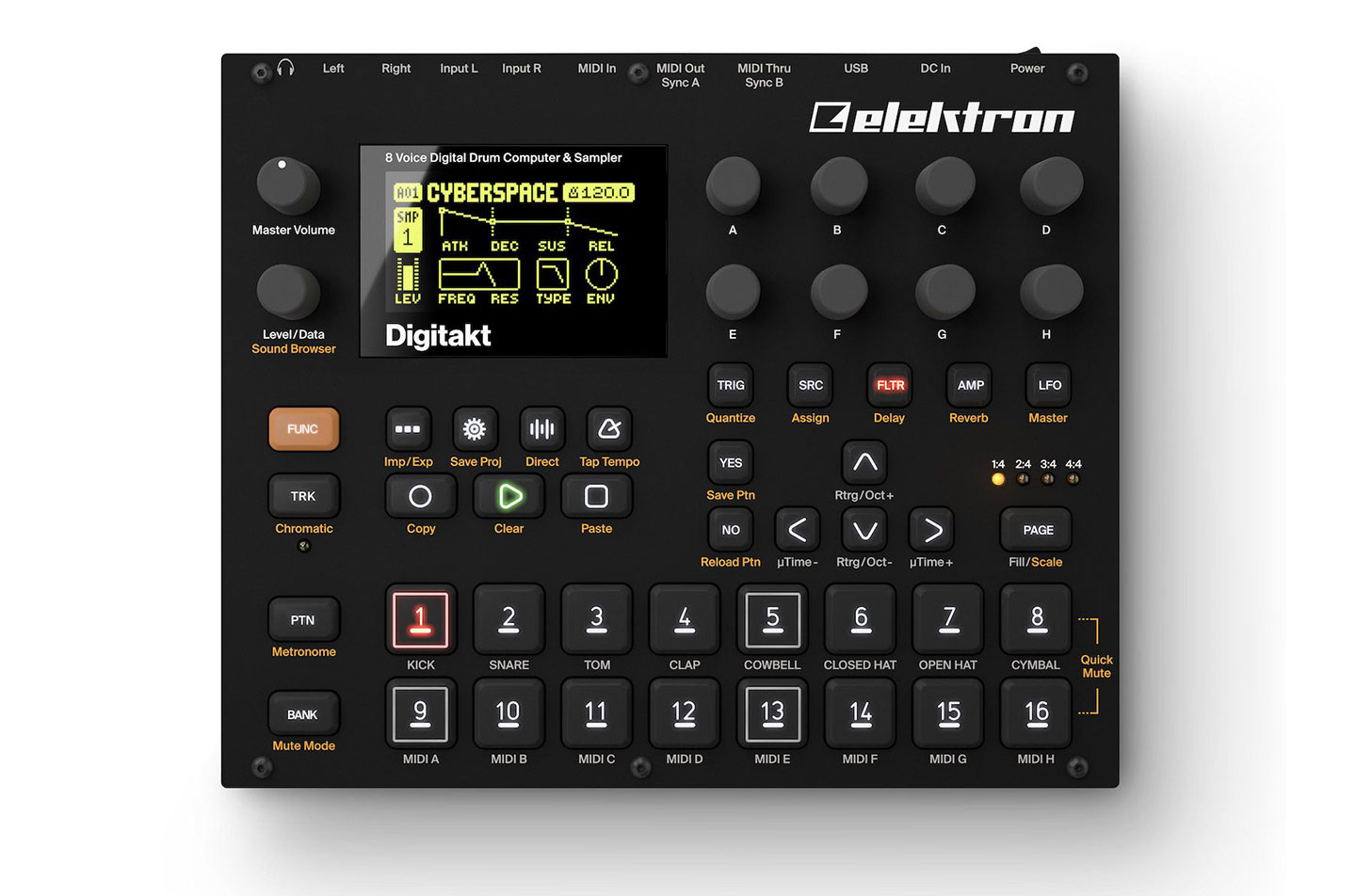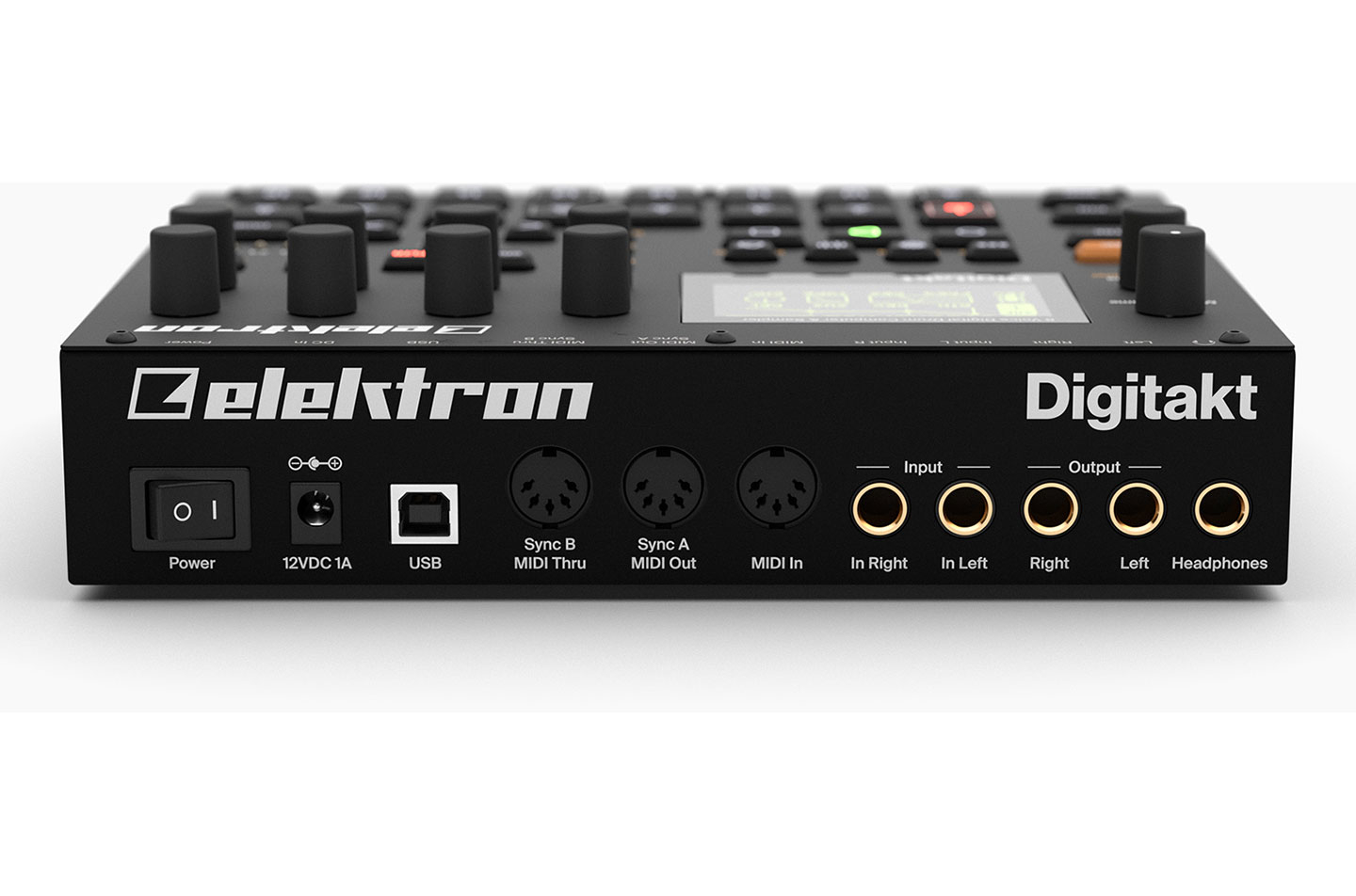- All instruments have their own logic and language but Elektron's is distinctive. The capabilities of their drum machines, synths and samplers are so extensive that they require real dedication to unlock their full potential. Even experienced producers are sometimes defeated by the task. Where some instruments can be learned through play, Elektron practically demands you read the entire manual and learn things inside out. But this is merely the cost of packing traditional electronic instruments with a lot of power. Every step of a sequence can be a unique event. Probability can be introduced in ways that create endless musical variation. The sound is crisp, round, punchy, three-dimensional. Those who persist and become fluent with the workflow often keep learning new things about their instrument.
Until recently, Elektron had dealt almost exclusively in flagship products. Much of their line sells for more than €1,000—elite tools priced beyond many people's reach. The Digitakt caused quite a stir because of its relatively approachable price tag. €770 is still a serious decision for most of us, but it's the most accessible Elektron has ever been. What's more, the Digitakt is built for speed. It's not light on features but it feels economised and immediate. As such, it's the most generous instrument they've made.
By avoiding synthesis all together and working exclusively with samples, Digitakt is more focused than other Elektron products. While it lacks a lot of capabilities found in the Octatrack or Analog RYTM, this makes for a faster workflow that aids creativity. You can't time stretch samples, there's no analogue engine, everything's in mono yet I didn't feel at all held back. On the contrary, I was surprised at how quickly ideas could spiral off course into uncharted territory, even with the stock samples.
Admittedly, much of this has to do with functions found on other Elektron machines. Yet the simplified workflow makes a difference. The process of jamming out a sequence, experimenting with parameter changes, saving patterns and undoing changes when things go wrong makes for fluid, freewheeling idea creation. Being able to build upon fruitful improvisations when you're on a roll or revert back to earlier patterns when you're losing momentum is also vitally important in live performance.
I was reminded of the Dave Smith Tempest in this regard. The Tempest had a function where you could control the envelopes, filters and other parameters of every single instrument at once, which could then be instantly erased with an undo feature, allowing you to create intense, bizarre sounds for breakdowns or build-ups that can end with an emphatic drop. You can do much the same thing with the Digitakt by holding TRK and messing about with the parameters while the reload pattern function is safely just a button press away. What's more, you can apply it to parameters like sample selection, meaning every instrument simultaneously jumps to a different sample, creating impossibly shifting timbres. Very often, making across-the-board parameter changes leads to a more interesting sound overall, which can then be quickly saved and used as a variation from the original beat.
Combining what Elektron call parameter locks and trig conditions gives you a degree of control that brings sequences alive and gives them a dynamic musicality. Parameter locks allow you to dial in specific settings for multiple parameters of a certain sound on a per-step basis. This means you can have, say, different amp envelope, filter cutoff and effects settings from one step to the next on every single instrument. Then the trig conditions can introduce variability to these changes. For instance, you could set the parameter locks to have a 75% likelihood of being active on a certain step. The endless possibilities add life to the sound.
The same goes for all the CC messages on the eight MIDI tracks, which effectively give you parameter locking in your other hardware instruments—assuming they can receive MIDI CCs. You can sequence different track lengths, nudge individual notes backwards or forwards to create customised timing, send multiple MIDI tracks to the same destination or offset LFOs with parameter locks to generate alternately smooth and sudden changes in sound. Despite the workflow improvements, it does take some time to get to grips with the implications of all this. But once you've got a handle on it, Digitakt can easily function as a brain for your studio or live set. In fact, its MIDI sequencing abilities are perhaps its greatest strength.
The sound itself could be best described as clear. It has a crispness that makes transients seem especially present. As with past Elektron instruments, the overdrive helps to bring weaker and heavier sounds into alignment while parameter locking the bit reduction is great for IDM and electro style effects. Sampling is a stress free experience and the digital engine doesn't seem to colour the samples so much as bring them into alignment. You can use a wide variety of source fidelities, be they old records, YouTube clips, field recordings or whatnot, without them sounding obviously inferior to more hi-fi sounds, especially with extra processing. Being able to see the waveform while you're setting start, end and loop points is helpful. On that note, I found the simple act of changing the direction of sample playback and choosing a new loop point to be one of the best ways to make a sequence more interesting. Then you have the ability to use granular synthesis by looping short snippets of a sample, which can also be modulated by an LFO for that stuttering, sample-scanning sound.
Despite the fact that it bounces samples down to mono, Digitakt can be used as an advanced sound design tool. It is certainly geared at programming beats, but its MIDI sequencing and sound engine make it much more than a groovebox. Elektron wanted it to be one of those instruments that gives more than it takes. They've certainly delivered on that front. The core ideas behind it are simple and even old fashioned but the minor details add up into something new.
Ratings:
Cost: 3.8
Versatility: 4.8
Ease of use: 4.0
Sound: 4.8
 The same goes for all the CC messages on the eight MIDI tracks, which effectively give you parameter locking in your other hardware instruments—assuming they can receive MIDI CCs. You can sequence different track lengths, nudge individual notes backwards or forwards to create customised timing, send multiple MIDI tracks to the same destination or offset LFOs with parameter locks to generate alternately smooth and sudden changes in sound. Despite the workflow improvements, it does take some time to get to grips with the implications of all this. But once you've got a handle on it, Digitakt can easily function as a brain for your studio or live set. In fact, its MIDI sequencing abilities are perhaps its greatest strength. The sound itself could be best described as clear. It has a crispness that makes transients seem especially present. As with past Elektron instruments, the overdrive helps to bring weaker and heavier sounds into alignment while parameter locking the bit reduction is great for IDM and electro style effects. Sampling is a stress free experience and the digital engine doesn't seem to colour the samples so much as bring them into alignment. You can use a wide variety of source fidelities, be they old records, YouTube clips, field recordings or whatnot, without them sounding obviously inferior to more hi-fi sounds, especially with extra processing. Being able to see the waveform while you're setting start, end and loop points is helpful. On that note, I found the simple act of changing the direction of sample playback and choosing a new loop point to be one of the best ways to make a sequence more interesting. Then you have the ability to use granular synthesis by looping short snippets of a sample, which can also be modulated by an LFO for that stuttering, sample-scanning sound. Despite the fact that it bounces samples down to mono, Digitakt can be used as an advanced sound design tool. It is certainly geared at programming beats, but its MIDI sequencing and sound engine make it much more than a groovebox. Elektron wanted it to be one of those instruments that gives more than it takes. They've certainly delivered on that front. The core ideas behind it are simple and even old fashioned but the minor details add up into something new. Ratings: Cost: 3.8 Versatility: 4.8 Ease of use: 4.0 Sound: 4.8
The same goes for all the CC messages on the eight MIDI tracks, which effectively give you parameter locking in your other hardware instruments—assuming they can receive MIDI CCs. You can sequence different track lengths, nudge individual notes backwards or forwards to create customised timing, send multiple MIDI tracks to the same destination or offset LFOs with parameter locks to generate alternately smooth and sudden changes in sound. Despite the workflow improvements, it does take some time to get to grips with the implications of all this. But once you've got a handle on it, Digitakt can easily function as a brain for your studio or live set. In fact, its MIDI sequencing abilities are perhaps its greatest strength. The sound itself could be best described as clear. It has a crispness that makes transients seem especially present. As with past Elektron instruments, the overdrive helps to bring weaker and heavier sounds into alignment while parameter locking the bit reduction is great for IDM and electro style effects. Sampling is a stress free experience and the digital engine doesn't seem to colour the samples so much as bring them into alignment. You can use a wide variety of source fidelities, be they old records, YouTube clips, field recordings or whatnot, without them sounding obviously inferior to more hi-fi sounds, especially with extra processing. Being able to see the waveform while you're setting start, end and loop points is helpful. On that note, I found the simple act of changing the direction of sample playback and choosing a new loop point to be one of the best ways to make a sequence more interesting. Then you have the ability to use granular synthesis by looping short snippets of a sample, which can also be modulated by an LFO for that stuttering, sample-scanning sound. Despite the fact that it bounces samples down to mono, Digitakt can be used as an advanced sound design tool. It is certainly geared at programming beats, but its MIDI sequencing and sound engine make it much more than a groovebox. Elektron wanted it to be one of those instruments that gives more than it takes. They've certainly delivered on that front. The core ideas behind it are simple and even old fashioned but the minor details add up into something new. Ratings: Cost: 3.8 Versatility: 4.8 Ease of use: 4.0 Sound: 4.8